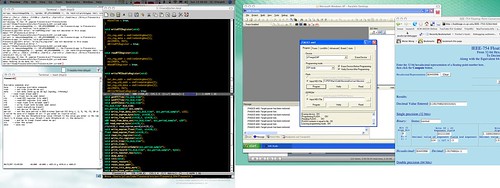In the midst of trying to finish this first run of Flavonoid boards — getting the firmware right, finding little gotchas in the design, little mistakes in the assembly process — I keep flipping back and forth between thinking about the minutiae of assembly and the craft work, and the 6-mile-up design theme. The minutiae is obsessive and completely tunes your head for basically just sitting in front of the tube (writing code, debugging code you’ve written, finding work-arounds, banging my head, asking Todbot for help with this and that.) Sometimes I almost forget why I’m making this thing.
So, for my own sanity. The Near Future Laboratory — Nicolas and I — are interested in experimenting with “offline gaming” — ways of interacting, particularly in mobile and pervasive contexts, that were digital and required some kind of engagement with physical aspects of the world. It was a way to begin investigating hybrid interaction rituals. Hybrid interaction rituals being those that coupled some action and activity related to the physical world, with digital practices.
One way we’ve been investigating this theme of offline gaming has been to speculate on simple kinds of game scenarios. One we are particularly keen on would work in the fashion of “accumulating” kinetic energy points by doing actual, physical activities. These kinetic nature of these activities — running, skipping, surfing, snowboarding, gardening — would accumulate these energy points which could be linked to power-ups of some sort within the digital game. So, physical activity in the normal, human physical world generates the potential for action in the digital game world, probably in an online environment. So, for example, your character in, say, WoW gets a — whatever — Rock of the Condor Sword because you’ve done a solid weekend of hiking and kyaking or something.
So, conceptually, there’s this mechanical linkage. You do something offline and see some representation of that offline activity, online, later.
Problem was — I really wanted to construct the device that would make that mechanical linkage. I played around with a few commercial pedometers, and thought about GPS, etc. I wanted the translation to be as seamless as possible. Dennis had experimented with using off-the-shelf pedometers translating the step numbers into a game grid. That’s the brilliant way about working on the problem. I personally found the pedometer a bit too instrumented. It wasn’t foot-falls I wanted to link to the digital representation of your physical activities — it was physical activity generally. So, more than just running or walking. But, suppose you garden? There’s not tons of walking to represent the activity. Or suppose you were a skateboarder or surfer? Pedometers aren’t particularly good for measuring that stuff.
I decided that I needed a more ambient accumulator of kinetic activity. A momentum-ometer. Or something.
At the most basic level, that’s what Flavonoid is — it measures changes in momentum across all real-world axes. What that means more simply is that it just records physical motion in every direction. It records this at time-based intervals that are configurable, and with a thresholding feature that allows you to ignore any motion below a particular threshold. Each data set records the accumulated changes in acceleration and the maximum change in acceleration for that period.
Two acceleration readings are taken at a time, with 100ms interval. The difference (change) in acceleration is what I record. Why change in acceleration? Because, by my estimation, that’s an indication of change in momentum, which is closer to work-done. I could be wrong — but its a convenient enough place to start. The main point is that I’m less particularly concerned with what the numbers mean specifically and more that they’re directly related to physical activity. No one would “count” accumulated changes in acceleration as they would accumulated number of foot-falls. But, these numbers can serve as a suitable input to the offline game experience just fine.
I also made this as a basis for a number of other projects within this general theme of creating hybrid interaction rituals. We needed some sort of device that could correlate physical activity and put it in a digital form that was amenable to a variety of different expressions. I had first hoped that a “connected” pedometer would work, generally — but many of these are closed systems, using proprietary interfaces. So, even if the pedometer did measure what I wanted it to measure (ambient activity rather than foot-falls), I couldn’t easily extract the data. That’d only work by hand, which wasn’t ideal.


You can try to hack a http://www.powerballs.com
http://www.youtube.com/watch?v=hpJ_olNeZp8
More seriously, it could be also very interesting to create a devices that produces it own electricity according to motion and embed it in something that makes it break if you open it (some kind of super resistant acrylic). Then, it would be super hard to hack it, which is the obvious first thing that everybody would like to do with such devices.
For exemple, i’m thinking about these little electro-delicacies,
the sugar-cube-sized electric generators that feed on environmental vibrations :
http://www.newscientisttech.com/article.ns?id=dn12190&feedId=tech_rss20
Cheers,
j*b